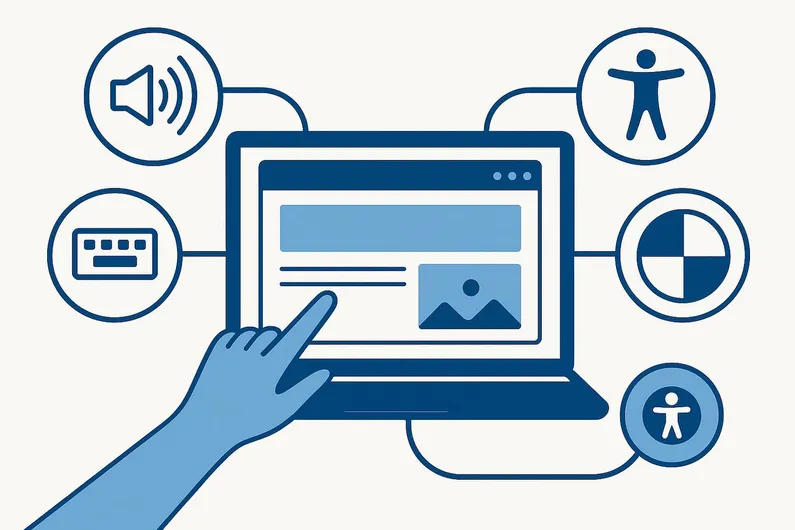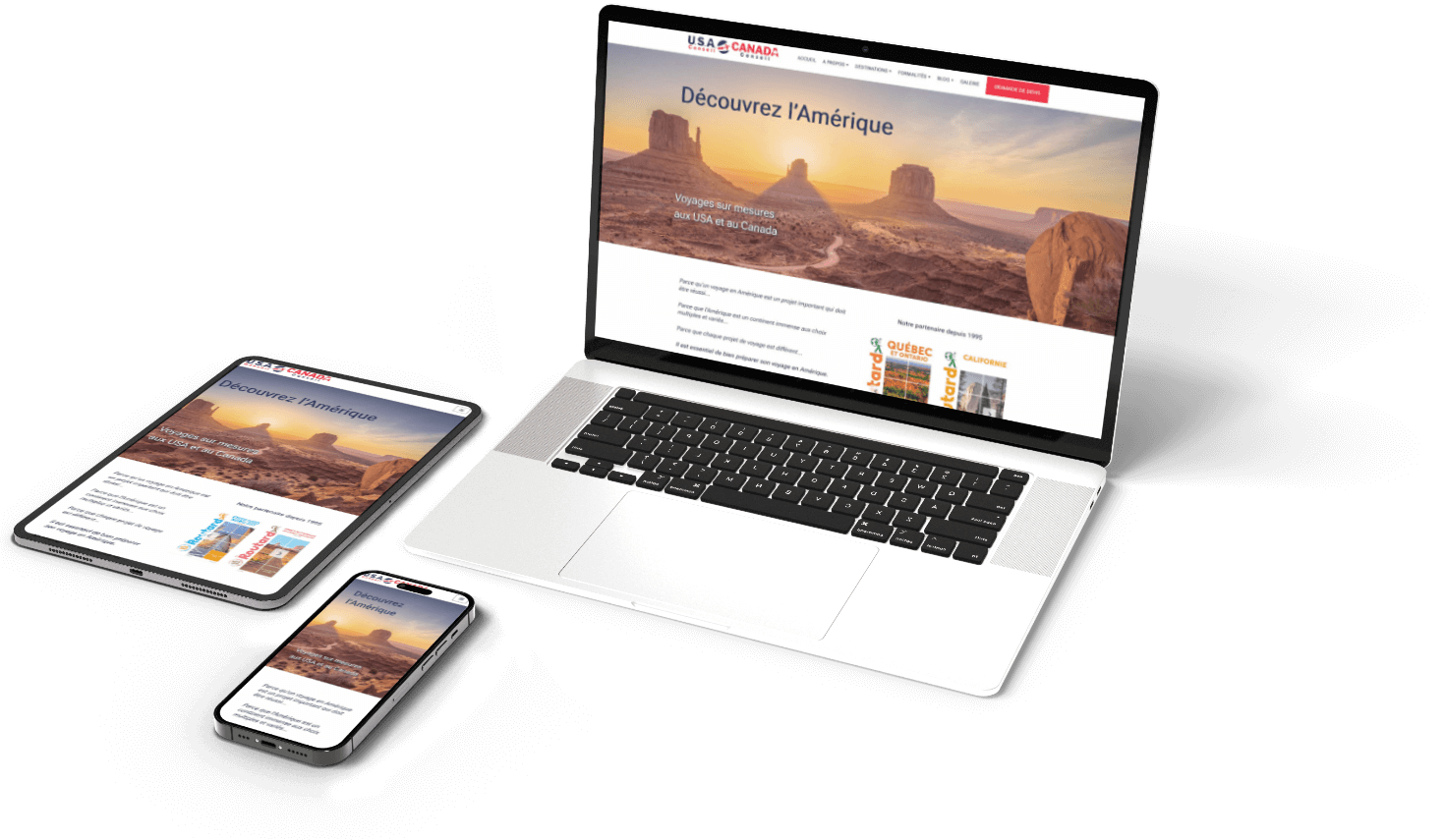
Make Your Website ADA Compliant | Business Owner Guide
Accessibility is no longer optional. In 2026, small businesses face increasing legal pressure, higher user expectations, and rapidly evolving web standards. Ensuring your website is accessible protects your business, improves SEO, and provides a better experience for all users.
This guide explains what ADA compliance means today, how WCAG 2.1 and 2.2 apply to websites, the most common accessibility issues, and what steps you can take to reduce risk and improve usability. At Oui Digital, we help businesses build fast, accessible websites from day one, but the principles below apply no matter who maintains your site.

What ADA Compliance Means in 2026
The Americans with Disabilities Act (ADA) requires that public-facing spaces — including websites — be accessible to people with disabilities. Although the law predates modern internet usage, courts consistently interpret business websites as “places of public accommodation.”
In practice, that means businesses are expected to follow the WCAG accessibility guidelines, even though they aren’t written directly into U.S. law.
Why Accessibility Matters
- Legal protection: Tens of thousands of demand letters and lawsuits target small businesses each year.
- Bigger audience reach: 1 in 4 U.S. adults lives with a disability.
- Better SEO: Google rewards semantic, well-structured, keyboard-friendly websites.
- Improved user experience: Clear structure and better readability benefit everyone.
- Brand trust: Accessible businesses are perceived as more professional and inclusive.
Understanding WCAG (2.1 & 2.2)
WCAG (Web Content Accessibility Guidelines) are the international standards used to measure accessibility. As of 2026, the relevant versions are WCAG 2.1 and WCAG 2.2, with WCAG 3.0 still in draft form.
Businesses should aim for WCAG 2.1 or 2.2 Level AA.
WCAG Principles (POUR)
1. Perceivable
Your content must be accessible to all senses.
- Alt text for images
- Captions and transcripts
- Sufficient color contrast
- Content readable when zoomed 200%
- Avoid images of text
2. Operable
Everything must be usable with a keyboard.
- Full keyboard access
- Visible focus indicators
- No auto-playing animations that trigger seizures
- Clear, consistent navigation
- Adjustable time limits
3. Understandable
Your website must be easy to follow.
- Predictable layout
- Clear labels and instructions
- Helpful error messages
- Consistent formatting
4. Robust
Content must work with assistive technology.
- Compatible HTML
- Correct ARIA usage
- Proper headings, roles, and labels
Common Accessibility Issues (and How to Fix Them)
Below are the issues most often cited in ADA lawsuits and accessibility audits.
1. Missing Alt Text
Images without alt text are invisible to screen readers.
<!-- Bad -->
<img src="chair.jpg" alt="" />
<!-- Good -->
<img src="chair.jpg" alt="Modern wooden chair with black cushion" />2. Low Color Contrast
Common failure: light gray text on light backgrounds.
Minimum WCAG ratios:
- Normal text: 4.5:1
- Large text (18px+): 3:1
3. Inaccessible Forms
Typical issues:
- Missing labels
- Unclear instructions
- No error messages
<label for="email">Email address</label>
<input type="email" id="email" name="email" required />Forms should also:
- Provide clear error messages
- Use helpful hints (for example, “Format: [email protected]”)
- Follow a logical tab order
4. Keyboard Navigation Issues
Fix by:
- Testing with Tab, Shift+Tab, Enter, Space
- Adding focus outlines
- Ensuring menus open on click, not hover
- Avoiding “focus traps” where users cannot escape a section
5. Broken Heading Structure
Follow hierarchical order:
h1 → h2 → h3 → h4Do not skip heading levels just for visual style.
6. Accessibility Overlays
Accessibility overlays and “one-click” widgets do not fix accessibility. They:
- Break screen readers and assistive tools
- Mask underlying code issues
- Have been cited in multiple lawsuits
Avoid them and fix the underlying problems instead.
Updated ADA Compliance Tools (2026)
Automated Tools
These tools help you quickly identify many common issues:
- axe DevTools (Chrome and Firefox)
- WAVE browser extension
- Lighthouse Accessibility in Chrome DevTools
- Contrast checkers (for example, WebAIM)
Automated tools catch only 30–40% of issues, so they are a starting point, not the final answer.
Manual Testing (Required)
Every serious accessibility effort must include manual tests:
- Navigate your site using only the keyboard
- Test with a screen reader (JAWS, NVDA, VoiceOver)
- Zoom pages to 200% and check readability
- Temporarily disable CSS to verify content order and structure
When You Need a Professional Audit
A professional audit is strongly recommended if:
- You run an e-commerce site
- You operate in healthcare, education, finance, or other regulated sectors
- You have received a complaint or demand letter
At Oui Digital, accessibility remediation is built into our development process so our clients avoid expensive retrofits later.
ADA Compliance Checklist (2026)
Use this as a practical roadmap. You can adapt it to your team and tools.
Phase 1: Audit Your Site
- Run one or more automated scanners
- Manually test keyboard navigation
- Perform a quick screen reader review
- Document all issues found
Phase 2: Fix Critical Issues First
- Add alt text to meaningful images
- Fix contrast failures
- Remove keyboard traps
- Add labels and error messages to forms
Phase 3: Improve Semantics and Structure
- Use semantic HTML (headings, lists, buttons, links)
- Keep heading levels in order
- Add ARIA roles only when necessary
Phase 4: Make Media Accessible
- Add captions to videos
- Provide transcripts for audio content
- Avoid flashing or strobing animations
Phase 5: Test with Real Users
Where possible, include people who rely on assistive technology in your testing. Their feedback is invaluable.
Phase 6: Publish an Accessibility Statement
Your statement should include:
- Your overall commitment to accessibility
- Any known limitations
- A way to contact you to report issues
- How often you intend to review and update accessibility
Phase 7: Maintain Accessibility Over Time
Accessibility is an ongoing process. New features, plugins, and content must be checked regularly. Build accessibility into your content and development workflows, not just as a one-off project.
Legal Considerations (2026)
ADA & Unruh (California)
- ADA Title III applies to most public-facing businesses in the U.S.
- The Unruh Civil Rights Act in California adds statutory damages on top of ADA claims.
- New York, California, and Florida see the highest volume of web accessibility lawsuits.
- 70–80% of lawsuits target small and medium-sized businesses, not just large corporations.
Cost of Non-Compliance
Approximate ranges (not legal advice):
- Demand letters: $5,000–$20,000
- Settlements: $5,000–$50,000+
- Attorney fees: $15,000–$100,000
- Remediation after a lawsuit: $5,000–$50,000
Being proactive with accessibility is almost always less expensive than responding to a lawsuit under time pressure.
What Accessibility Costs (2026)
DIY Approach
- Time: 20–40 hours or more, depending on your site
- Tools: Mostly free or low-cost
- Risk: Critical issues can be missed without expertise
Professional Approach
- Accessibility audits: $2,000–$10,000
- Remediation projects: $5,000–$50,000 (depending on scope)
- Ongoing accessibility maintenance: $300–$1,500/month
These ranges are broad but reflect real-world budgets for serious accessibility work.
Getting Started Today
If you want to protect your business, improve user experience, and build a website that works for everyone, accessibility needs to be part of your ongoing strategy, not an afterthought.
For businesses that want help getting it right from the start, Oui Digital designs and develops fast, accessible, SEO-ready websites with WCAG-informed design and performance-first development.
👉 Get an accessibility review from Oui Digital
👉 Learn more about performance-focused web design
👉 Run a full SEO audit using our guide




